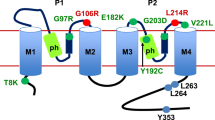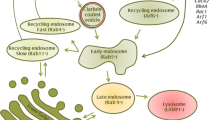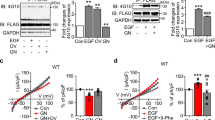Abstract
The HERG (KCNH2) channel is a voltage-sensitive potassium channel mainly expressed in cardiac tissue, but has also been identified in other tissues like neuronal and smooth muscle tissue, and in various tumours and tumour cell lines. The function of HERG has been extensively studied, but it is still not clear what mechanisms regulate the surface expression of the channel. In the present report, using human embryonic kidney cells stably expressing HERG, we show that diacylglycerol potently inhibits the HERG current. This is mediated by a protein kinase C-evoked endocytosis of the channel protein, and is dependent on the dynein–dynamin complex. The HERG protein was found to be located only in early endosomes and not lysosomes. Thus, diacylglycerol is an important lipid participating in the regulation of HERG surface expression and function.









Similar content being viewed by others
References
Levitan IB (1994) Modulation of ion channels by protein phosphorylation and dephosphorylation. Annu Rev Physiol 56:737–745
Warmke JW, Ganetzky B (1994) A family of potassium channel genes related to eag in Drosophila and mammals. Proc Natl Acad Sci USA 91:3438–3442
Sanguinetti MC, Jiang C, Curran ME, Keating MT (1995) A mechanistic link between an inherited and an acquired cardiac arrhythmia: HERG encodes the IKr potassium channel. Cell 81:299–307
Curran ME, Splawski I, Timothy KW, Vincent GM, Green ED, Keating MT (1995) A molecular basis for cardiac arrhythmia: HERG mutations cause long QT syndrome. Cell 80:795–803
Brugada R, Hong K, Dumaine R, Cordeiro J, Gaita F, Borggrefe M, Menendez TM, Brugada J, Pollevick GD, Wolpert C, Burashnikov E, Matsuo K, Guerchicoff A, Bianchi F, Guistetto C, Schimpf R, Brugada P (2004) Sudden death associated with short-QT syndrome linked to mutations in HERG. Circulation 109:30–35
Yap YG, Camm AJ (2003) Drug induced QT prolongation and torsades de pointes. Heart 89:1363–1372
Chiesa N, Rosati B, Arcangeli A, Olivotto M, Wanke E (1997) A novel role for HERG K+ channels: spike-frequency adaptation. J Physiol 501:313–318
Farrelly AM, Ros S, Callaghan BP, Khoyi MA, Flemming N, Horowitz B, Sanders KM, Keef KD (3003) Expression and function of KCNH2 (HERG) in the human jejunum. Am J Physiol Gastrointest Liver Physiol 284:G883–G895
Rosati B, Marchetti P, Crociani O, Lecchi M, Lupi RA, Arcangeli A, Olivotto M, Wanke E (2000) Glucose- and arginine-induced insulin secretion by human pancreatic beta-cells: the role of HERG K(+) channels in firing and release. FASEB J. 14:2601–2610
Lastraioli E, Guasti L, Crociani O, Polvani S, Hofmann G, Witchel H, Bencini L, Calistri M, Messerini L, Scatizzi M, Moretti PA, Wanke E, Olivotto M, Mugnai G, Arcangeli A (2004) herg1 gene and HERG1 protein are overexpressed in colorectal cancers and regulate cell invasion of tumor cells. Cancer Res 64:606–611
Wang H, Zhang Y, Cao L, Han H, Wang J, Yang B, Nattel S, Wang Z (2002) HERG K+ channel, a regulator of tumor cell apoptosis and proliferation. Cancer Res 62:4843–4848
Johannes FJ, Prestle J, Dieterich S, Oberhagemann P, Link G, Pfizenmaier K (1995) Characterization of activators and inhibitors of protein kinase C mu. Eur J Biochem 15:303–307
Canagarajah B, Leskow FC, Ho JY, Mischak H, Saidi LF, Kazanietz MG, Hurley JH (2004) Structural mechanism for lipid activation of the Rac-specific GAP, beta2-chimaerin. Cell 119:407–418
Attali B, Honoré E, Lesage F, Lazdunski M, Bathain J (1992) Regulation of a major cloned voltage-gated K+ channel from human T lymphocytes. FEBS Lett 303:229–232
Lo CF, Numann R (1998) Independent and exclusive modulation of cardiac delayed rectifying K+ current by protein kinase C and protein kinase A. Circ Res 83:995–1002
Bian J, Cui J, McDonald TV (2001) HERG K(+) channel activity is regulated by changes in phosphatidyl inositol 4, 5-bisphosphate. Circ Res 89:1168–1176
Wu S-N, Lo Y-K, Kuo B, Ching H-T (2001) Ceramide inhibits the inwardly rectifying potassium current in GH3 lactotrophes. Endocrinology 142:4785–4794
Chapman H, Ramström C, Korhonen L, Laine M, Wann KT, Lindholm D, Pasternack M, Törnquist K (2005) Down-regulation of the HERG (KCNH2) K+ channel by ceramide: Evidence for ubiquitin-mediated lysosomal degradation. J Cell Sci 118:5325–5334
Thomas D, Zhang W, Wu K, Wimmer AB, Gut B, Wendt-Nordahl G, Kathöfer S, Kreye VA, Kathus HA, Schoels W, Kiehn J, Karle CA (2003) Regulation of HERG potassium channel activation by protein kinase C independent of direct phosphorylation of the channel protein. Cardiovasc Res 59:14–26
Barros F, Gomez-Varela D, Vitoria CG, Giraldéz T, de la Pena P (1998) Modulation of human erg K+ channel gating by activation of a G protein-coupled receptor and protein kinase C. J Physiol 511:333–346
Cockerill SL, Tobin AB, Torrecilla I, Willars GB, Standen NB, Mitcheson JS (2007) Modulation of hERG potassium currents in HEK-293 cells by protein kinase C. Evidence for direct phosphorylation f pore forming subunits. J Physiol 581:479–493
Arcangeli AFB, Becchetti A, Faravelli L, Coronello M, Mini E, Olivotto M, Wanke E (1995) A novel inward-rectifying K+ current with a cell-cycle dependence governs the resting potential of mammalian neuroblastoma cells. J Physiol 489:455–471
Zhou Z, Gong Q, Ye B, Fan Z, Makielski JC, Robertson GA, January CT (1998) Properties of HERG channels stably expressed in HEK 293 cells studied at physiological temperature. Biophys J 74:230–241
Kass GEN, Duddy SK, Orrenius S (1989) Activation of hepatocyte protein kinase C by redox-cycling quinones. Biochem J 260:499–507
Nong Y, Huang YO, Ju W, Kalia LV, Ahmadian G, Wang YT, Salter MW (2003) Glycine binding primes NMDA receptor internalization. Nature 422:302–307
Crociani O, Guasti L, Balzi M, Becchetti A, Wanke E, Olivotto M, Wymore RS, Arcangeli A (2003) Cell cycle-dependent expression of HERG1 and HERG1B isoforms in tumor cells. J Biol Chem 278:2947–2955
Liscovitch M (1992) Crosstalk among multiple signal-activated phospholipases. Trends Biochem Sci 17:393–399
Asaoka Y, Nakamura S, Yoshida K, Nishizuka Y (1992) Protein kinase C, calcium and phospholipid degradation. Trends Biochem Sci 17:414–417
Wang YH, Shi CX, Dong F, Sheng JW, Xu YF (2008) Inhibition of the rapid component of the delayed rectifier potassium current in ventricular myocytes by angiotensin II via the AT1 receptor. Br J Pharmacol 154:429–439
Schledermann W, Wulfsen I, Schwrz JR, Bauer CK (2001) Modulation of rat erg1, erg2, erg3 and HERG K+ currents by thyrotropin-releasing hormone in anterior pituitary cells via the native signal cascade. J Physiol 532:143–163
Gomez-Varela D, Giraldéz T, de la Pena P, Dupuy SG, Garcia-Manso D, Barros F (2003) Protein kinase C is necessary for recovery from the thyrotropin-releasing hormone-induced r-ERG current reduction in GH3 rat anterior pituitary cells. J Physiol 547:913–929
Delmas P, Brown DA (2005) Pathways modulating neural KCNQ/M (Kv7) potassium currents. Nat Rev Neurosci 6:850–862
Heath BM, Terrar DA (2000) Protein kinase C enhances the rapidly activating delayed rectifier potassium current, IKr, through a reduction in C-type inactivation in guinea-pig ventricular myocytes. J Physiol 522:391–402
Leaney JL, Dekker LV, Tinker A (2001) Regulation of a G protein-gated inwardly rectifying K+ channel by a Ca(2+)-independent protein kinase C. J Physiol 534:367–379
Perillan PR, Chen M, Potts EA, Simard JM (2002) Transforming growth factor-beta 1 regulates Kir2.3 inward rectifier K+ channels via phospholipase C and protein kinase C-delta in reactive astrocytes from adult rat brain. J Biol Chem 277:1974–1980
Karle CA, Zitron E, Zhang W, Wendt-Nordahl G, Kathöfer S, Thomas D, Gut B, Scholz E, Vahl CF, Katus HA, Kiehn J (2002) Human cardiac inwardly-rectifying K+ channel Kir(2.1b) is inhibited by direct protein kinase C-dependent regulation in human isolated cardiomyocytes and in an expression system. Circulation 106:1493–1499
Mao J, Wang X, Chen F, Wang R, Rojas A, Shi Y, Piao H, Jiang C (2004) Molecular basis for the inhibition of G protein-coupled inward rectifier K(+) channels by protein kinase C. Proc Natl Acad Sci USA 101:1087–1092
Lin DH, Sterling H, Lerea KM, Giebisch G, Wang WH (2002) Protein kinase C (PKC)-induced phosphorylation of ROMK1 is essential for the surface expression of ROMK1 channels. J Biol Chem 277:44278–44284
Nesti E, Everill B, Morielli AD (2004) Endocytosis as a mechanism for tyrosine kinase-dependent suppression of a voltage-gated potassium channel. Mol Biol Cell 15:4073–4088
Delaney KA, Murph MM, Brown LM, Radhakrishna H (2002) Transfer of M2 muscarinic acetylcholine receptors to clathrin-derived early endosomes following clathrin-independent endocytosis. J Biol Chem 277:33439–33446
Staub O, Abriel H, Plant P, Ishikawa T, Kanelis V, Saleki R, Horisberger JD, Schild L, Rotin D (2000) Regulation of the epithelial Na+ channel by Nedd4 and ubiquitination. Kidney Int 57:809–811
Zeng WZ, Babich V, Ortega B, Quigley R, White SJ, Welling PA, Huang CL (2002) Evidence for endocytosis of ROMK potassium channel via clathrin-coated vesicles. Am J Physiol Renal Physiol 283:F630–639
Choi WS, Khurana A, Mathur R, Viswanathan V, Steele DF, Fedida D (2005) Kv1.5 surface expression is modulated by retrograde trafficking of newly endocytosed channels by the dynein motor. Circ Res 97:363–371
Hu K, Huang CS, Jan YN, Jan LY (2003) ATP-sensitive potassium channel traffic regulation by adenosine and protein kinase C. Neuron 38:417–432
Herring D, Huang R, Singh M, Dillon GH, Leidenheimer NJ (2005) PKC modulation of GABAA receptor endocytosis and function is inhibited by mutation of a dileucin motif within the receptor beta 2 subunit. Neuropharmacology 48:181–194
Lan JY, Skeberdis VA, Jover T, Grooms SY, Lin Y, Araneda RC, Zheng X, Bennet MVL, Zukin RS (2001) Protein kinase C modulates NMDA receptor trafficking and gating. Nat Neurosci 4:382–390
Lin Y, Jover-Mangual T, Wong J, Bennet MVL, Zukin RS (2006) PSD-95 and PKC converge in regulating NMDA receptor trafficking and gating. Proc Natl Acad Sci USA 103:19902–19907
Sun H, Hu XQ, Moradel EM, Weight FF, Zhang L (2003) Modulation of 5-HT3 receptor-mediated response and trafficking by activation of protein kinase C. J Biol Chem 278:34150–34157
Thomas D, Kiehn J, Katus HA, Karle CA (2004) Adrenergic regulation of the rapid component of the cardiac delayed rectifier potassium curren, IKr, and the underlying hERG ion channel. Basic Res Cardiol 99:279–287
Bian JS, McDonald TV (2007) Phosphatidylinositol 4, 5-bisphosphate interactions with the HERG K + channel. Pflügers Arch Eur J Physiol 455:105–113
Priori SG, Napolitano C, Paganini V, Cantu F, Schwatz PJ (1997) Molecular biology of the long QT syndrome: impact on management. Pacing Clin Electrophysiol 20:2052–2057
Nishizuka Y (1992) Intracellular signaling by hydrolysis of phospholipids and activation of protein kinase C. Science 258:607–614
Acknowledgments
This study was supported by Minerva Foundation, the Receptor Research Programme (Åbo Akademi University and University of Turku), the Sigrid Juselius Foundation, the Liv och Hälsa Foundation, the Center of Excellence in Cell Stress (Åbo Akademi University), and the Academy of Finland. K.T. was a senior investigator of the Academy of Finland during part of the study.
Author information
Authors and Affiliations
Corresponding author
Rights and permissions
About this article
Cite this article
Ramström, C., Chapman, H., Viitanen, T. et al. Regulation of HERG (KCNH2) potassium channel surface expression by diacylglycerol. Cell. Mol. Life Sci. 67, 157–169 (2010). https://doi.org/10.1007/s00018-009-0176-2
Received:
Revised:
Accepted:
Published:
Issue Date:
DOI: https://doi.org/10.1007/s00018-009-0176-2




